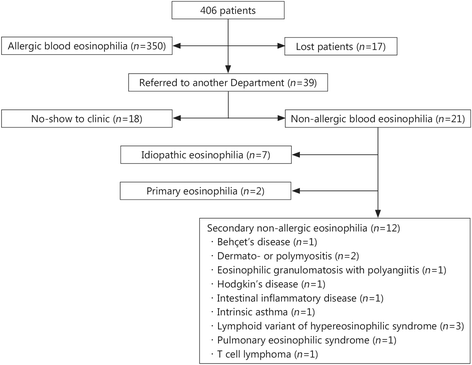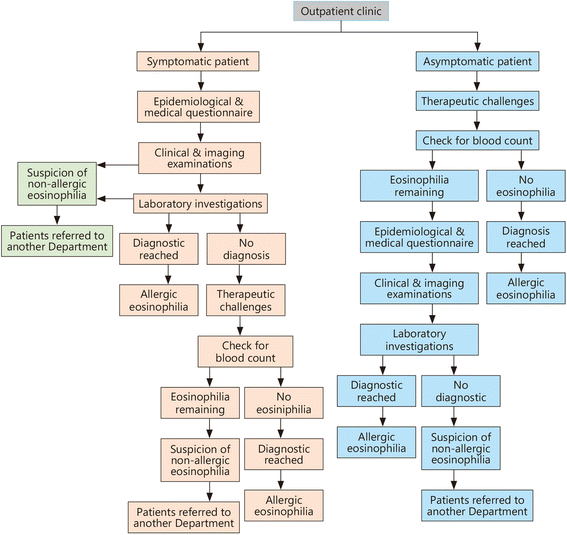A diagnostic protocol designed for determining allergic causes in patients with blood eosinophilia
- PMID: 28546866
- PMCID: PMC5440933
- DOI: 10.1186/s40779-017-0124-7
A diagnostic protocol designed for determining allergic causes in patients with blood eosinophilia
Abstract
Background: Blood eosinophilia is a common laboratory abnormality, and its characterization frequently represents a quandary for primary care physicians. Consequently, in France, specialists and particularly hematologists, often must investigate patients who present with blood eosinophilia that often, but not always, occurs because of allergic causes. Both the Departments of Hematology and Parasitology at Toulouse University Hospitals established a collaboration to rule out allergic causes of eosinophilia, particularly helminthiases, prior to initiating more sophisticated investigations.
Methods: Since 2004, the authors employed the same protocol to investigate eosinophilic outpatients who attended the clinic of Parasitology at Toulouse University Hospitals, and they reported the performance of this diagnostic procedure that was designed to be rapid (no hospitalization required) and only moderately expensive.
Results: A total of 406 patients who presented with blood eosinophilia greater than 0.5 (×109, giga cells per litter, G/L) had an allergic etiology in 350 (86.2%) cases. Among the remaining 56 subjects, 17 did not undergo a follow-up and 39 were referred to another specialized department, mostly Hematology. However, only 21 patients attended then were subsequently investigated. Non-allergic causes of eosinophilia, including 3 cases of the lymphoid variant of hypereosinophilic syndrome and 2 cases of myeloproliferative disorder, were identified in 14 patients, whereas 7 remained diagnosed as having idiopathic eosinophilia.
Conclusion: This study underlines the need to investigate patients presenting with even moderate blood eosinophilia. The work-up that was employed appears to be efficient and versatile and may be used by any medical specialist, such as in hematology, infectious disease, or internal medicine departments, who needs to investigate eosinophilic patients and should initially rule out any etiology of allergic eosinophilia.
Keywords: Allergy; Blood eosinophilia; Classification; Diagnostic protocol; Helminthiases; Secondary eosinophilias.
Figures
Similar articles
-
The causes of a peripheral blood eosinophilia in a secondary care setting.Clin Exp Allergy. 2021 Jul;51(7):902-914. doi: 10.1111/cea.13889. Epub 2021 Jun 3. Clin Exp Allergy. 2021. PMID: 34080735
-
Eosinophilia detected by automated blood cell counting in ambulatory North American outpatients. Incidence and clinical significance.Arch Pathol Lab Med. 1997 Sep;121(9):963-7. Arch Pathol Lab Med. 1997. PMID: 9302929
-
Diagnostic complexities of eosinophilia.Arch Pathol Lab Med. 2013 Feb;137(2):259-69. doi: 10.5858/arpa.2011-0597-RA. Arch Pathol Lab Med. 2013. PMID: 23368869 Review.
-
A practical workup for eosinophilia. You can investigate the most likely causes right in your office.Postgrad Med. 1999 Mar;105(3):193-4, 199-202, 207-10. doi: 10.3810/pgm.1999.03.638. Postgrad Med. 1999. PMID: 10086043 Review.
-
[Blood hypereosinophilias. III. Symptomatic hypereosinophilias: allergic, cutaneous, parasitic, infective, pulmonary and gastro- intestinal diseases].Minerva Med. 1985 Jun 8;76(24):1113-22. Minerva Med. 1985. PMID: 4011009 Italian.
Cited by
-
scFv against HSP60 of Strongyloides sp. and Its Application in the Evaluation of Parasite Frequency in the Elderly.Dis Markers. 2020 Jan 11;2020:4086929. doi: 10.1155/2020/4086929. eCollection 2020. Dis Markers. 2020. PMID: 32399087 Free PMC article.
-
Human toxocariasis and atopy.Parasite. 2020;27:32. doi: 10.1051/parasite/2020029. Epub 2020 May 13. Parasite. 2020. PMID: 32400389 Free PMC article.
-
A Retrospective Study of the Efficacy of Albendazole and Diethylcarbamazine for the Treatment of Human Toxocariasis.Pathogens. 2022 Jul 20;11(7):813. doi: 10.3390/pathogens11070813. Pathogens. 2022. PMID: 35890057 Free PMC article.
-
Therapy and Prevention for Human Toxocariasis.Microorganisms. 2022 Jan 22;10(2):241. doi: 10.3390/microorganisms10020241. Microorganisms. 2022. PMID: 35208697 Free PMC article.
-
Epidemiological, Clinical and Laboratory Features of Strongyloidiasis in 69 Attendees at a French Outpatient Clinic.Pathogens. 2023 Jul 27;12(8):983. doi: 10.3390/pathogens12080983. Pathogens. 2023. PMID: 37623943 Free PMC article.
References
-
- van Assendelft OW. Reference values for the total and differential leukocyte count. Blood Cells. 1985;11:77–96. - PubMed
MeSH terms
LinkOut - more resources
Full Text Sources
Other Literature Sources
Medical



